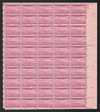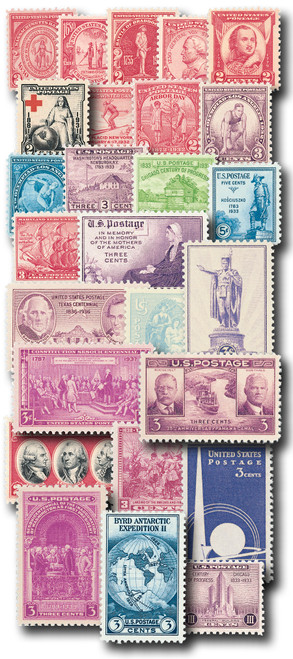
1939 3c Four States Statehood 50th Anniversary
# 858 - 1939 3c Four States Statehood 50th Anniversary
$0.35 - $30.00
U.S. #858
1939 3¢ Statehood – Wash., Mont., N.D., S.D.
1939 3¢ Statehood – Wash., Mont., N.D., S.D.
Issue Date: November 2, 1939
First City: Bismarck, North Dakota, and Pierre, South Dakota
Quantity Issued: 66,835,000
Printed by: Bureau of Engraving and Printing
Printing Method: Rotary Press
Perforation: 11x10 ½
Color: Rose violet
First City: Bismarck, North Dakota, and Pierre, South Dakota
Quantity Issued: 66,835,000
Printed by: Bureau of Engraving and Printing
Printing Method: Rotary Press
Perforation: 11x10 ½
Color: Rose violet
U.S. #858 was one of nine stamps for which U.S. President Franklin D. Roosevelt drew the designs. It honored the 50th anniversary of the addition of four states. In November of 1889, four states were admitted to the Union – North Dakota and South Dakota on November 2nd, Montana on November 8th, and Washington on November 11th.
Three of the four states shown on U.S. #858 border Canada. The U.S.-Canadian border curves at that point. Roosevelt – always a stickler for detail – correctly sketched the design showing that curve. The design made the states resemble laundry hanging on a wash line, leading to the stamp’s nickname of the “clothesline stamp.”
FDR – A President’s Stamp Collection
U.S. President Franklin D. Roosevelt was an avid stamp collector. While President, he took a very active hand in the development and design of U.S. stamps. He proposed themes, suggested colors and designs, and even made sketches for new stamps. Roosevelt had a hand in about 200 new stamps. On the morning of the day he died (April 12, 1945), Roosevelt approved the design for “Towards United Nations” (U.S. #928).
After his death, Roosevelt’s personal collection was offered in four auctions in New York City in 1946. While President, he had received items such as U.S. essays and die proofs of 20th century stamps. This raised a controversy, as some philatelists argued that such items actually belonged to the U.S. government. Still, many people wanted to own an “FDR stamp” and even common, modern stamps from his collection brought high prices far beyond normal value.
U.S. #858
1939 3¢ Statehood – Wash., Mont., N.D., S.D.
1939 3¢ Statehood – Wash., Mont., N.D., S.D.
Issue Date: November 2, 1939
First City: Bismarck, North Dakota, and Pierre, South Dakota
Quantity Issued: 66,835,000
Printed by: Bureau of Engraving and Printing
Printing Method: Rotary Press
Perforation: 11x10 ½
Color: Rose violet
First City: Bismarck, North Dakota, and Pierre, South Dakota
Quantity Issued: 66,835,000
Printed by: Bureau of Engraving and Printing
Printing Method: Rotary Press
Perforation: 11x10 ½
Color: Rose violet
U.S. #858 was one of nine stamps for which U.S. President Franklin D. Roosevelt drew the designs. It honored the 50th anniversary of the addition of four states. In November of 1889, four states were admitted to the Union – North Dakota and South Dakota on November 2nd, Montana on November 8th, and Washington on November 11th.
Three of the four states shown on U.S. #858 border Canada. The U.S.-Canadian border curves at that point. Roosevelt – always a stickler for detail – correctly sketched the design showing that curve. The design made the states resemble laundry hanging on a wash line, leading to the stamp’s nickname of the “clothesline stamp.”
FDR – A President’s Stamp Collection
U.S. President Franklin D. Roosevelt was an avid stamp collector. While President, he took a very active hand in the development and design of U.S. stamps. He proposed themes, suggested colors and designs, and even made sketches for new stamps. Roosevelt had a hand in about 200 new stamps. On the morning of the day he died (April 12, 1945), Roosevelt approved the design for “Towards United Nations” (U.S. #928).
After his death, Roosevelt’s personal collection was offered in four auctions in New York City in 1946. While President, he had received items such as U.S. essays and die proofs of 20th century stamps. This raised a controversy, as some philatelists argued that such items actually belonged to the U.S. government. Still, many people wanted to own an “FDR stamp” and even common, modern stamps from his collection brought high prices far beyond normal value.











